-
PESQUISA01/01/2018
Professional exhaustion, quality and intentions among family health nurses
Revista Brasileira de Enfermagem. 2018;71:2295-2301
Resumen
PESQUISAProfessional exhaustion, quality and intentions among family health nurses
Revista Brasileira de Enfermagem. 2018;71:2295-2301
DOI 10.1590/0034-7167-2016-0510
Visualizações0Ver maisABSTRACT
Objective:
to analyze how family health nurses assess quality of care; check if they have any intention of leaving their current job and nursing; estimate prevalence of professional exhaustion; and correlate these variables.
Method:
cross-sectional and correlational study with 198 nurses. The Maslach Burnout Inventory was applied, as it has questions for characterizing nurses, assessing perception on quality of care and of material and human resources, and verifying intention of leaving current work and nursing.
Results:
most nurses assess quality of care as good, 28.0% present emotional exhaustion, there is intention of leaving current work and nursing.
Conclusions:
family health nurses experience professional exhaustion, which in turn presents correlation with decreased quality of care and increased intentions of leaving current work and nursing.
-
PESQUISA01/01/2018
Ombudsman’s experience in Psychosocial Care Centers for alcohol/drugs
Revista Brasileira de Enfermagem. 2018;71:2287-2294
Resumen
PESQUISAOmbudsman’s experience in Psychosocial Care Centers for alcohol/drugs
Revista Brasileira de Enfermagem. 2018;71:2287-2294
DOI 10.1590/0034-7167-2017-0924
Visualizações0Ver maisABSTRACT
Objective:
The objective of the study was to analyze criticisms, compliments and suggestions of users, family and workers, placed in an Ombudsman of a Centro de Atenção Psicossocial para Álcool e outras Drogas (Psychosocial Care Centers for Alcohol and Other Drugs- CAPS ad).
Method:
A study carried out in the CAPS ad of Macapá-AP from August to December 2016, through the thematic content analysis of the files deposited in the ombudsman, recently introduced in the service, containing criticisms, compliments and suggestions from users, family members, and CAPS ad.
Results:
It was observed the dissatisfaction with the infrastructure of the CAPS ad, and with the relationships built between users and professionals, in addition, suggestions were given of workshops, and improvement in the development of the Projeto Terapêutico Singular (freely translated as Unique Therapeutic Project).
Final considerations:
It is concluded that the multidisciplinary team needs to put in practice the real psychosocial care in the service, and that the management helps in the improvement of the service’s place, and in the proposal of qualifications to this team.
-
PESQUISA01/01/2018
Nursing students’ sense perception of communication in psychiatric hospital
Revista Brasileira de Enfermagem. 2018;71:2280-2286
Resumen
PESQUISANursing students’ sense perception of communication in psychiatric hospital
Revista Brasileira de Enfermagem. 2018;71:2280-2286
DOI 10.1590/0034-7167-2017-0957
Visualizações0Ver maisABSTRACT
Objective:
to analyze the sense perception of nursing students in the learning of communication in a psychiatric hospital.
Method:
qualitative, exploratory and descriptive, from representative drawings of the communication perceived by the body senses of 23 nursing students, and recorded enunciation of the remarkable experiences after the end of the practical activities. The data were analyzed according to thematic content.
Results:
the heart captures perceptions, favoring interpersonal relationships; smelling shows care lacking in hospitalization; vision monopolizes the impressions of reality, making the movements static; hearing is exercised in the amplitude to listen; touching demarcates limitations of contact and interaction; and tasting, as social sense, seeks to overcome the obstacles to take care.
Conclusion:
the learning of communication was significant, making the psychiatric hospital a space to listen to what is inside, to find in the emotions and rationalities the sensations that can be inside and outside the tension nodes that interfere in the perceptions.
-
PESQUISA01/01/2018
Feelings of families regarding drug dependence: in the light of comprehensive sociology
Revista Brasileira de Enfermagem. 2018;71:2272-2279
Resumen
PESQUISAFeelings of families regarding drug dependence: in the light of comprehensive sociology
Revista Brasileira de Enfermagem. 2018;71:2272-2279
DOI 10.1590/0034-7167-2018-0150
Visualizações0Ver maisABSTRACT
Objective:
to understand the feelings of families before drug dependence.
Method:
exploratory, analytical and qualitative study carried out with families of drug users, which are followed up by the Centro de Atenção Psicossocial Álcool e Drogas (Psychosocial Care Center for Alcohol and DARUGS). The collection of data took place by in-depth interview, with the support of field diary. Three visits were done, on average, for each family. The software IRAMUTEQ was adopted for textual corpus organization and was discussed in the light of Michel Maffesoli.
Results:
nine families participated in the research; from the analysis, four classes arose: “My life has changed a lot because of drugs”; “I fear leaving him alone”; “I trust and have faith in God”, and “I am always worried in my own house”.
Final considerations:
the families revealed how much drug dependence did not only affect the user, but also the whole family, provoking in the family complex feelings and emotions.

-
PESQUISA01/01/2018
Project K: Training for hospital-community safe transition
Revista Brasileira de Enfermagem. 2018;71:2264-2271
Resumen
PESQUISAProject K: Training for hospital-community safe transition
Revista Brasileira de Enfermagem. 2018;71:2264-2271
DOI 10.1590/0034-7167-2018-0190
Visualizações0Ver maisABSTRACT
Objective:
To define the safe transition process from hospital to community of patients with chronic mental disorders and their families.
Method:
This was an action research study included in the constructivist paradigm. The participants in the study were nurses from a psychiatry service and from primary healthcare services.
Results:
After the identification of causes of continuity fragmentation, the following items emerged from the participants’ speeches: a) two criteria categories for safe transition (those associated with health status, dependence level, and self-care capacity of patients, and those associated with knowledge and competence level of informal caregivers); b) the design of an algorithm to facilitate clinical decision-making.
Final considerations:
In order to promote adherence to therapeutic treatment in the hospital-community transition, treatment plans must include patients and their families, and improve communication networks and support among care levels.

-
PESQUISA01/01/2018
Screening and Brief Intervention for the use of alcohol and other drugs
Revista Brasileira de Enfermagem. 2018;71:2258-2263
Resumen
PESQUISAScreening and Brief Intervention for the use of alcohol and other drugs
Revista Brasileira de Enfermagem. 2018;71:2258-2263
DOI 10.1590/0034-7167-2017-0444
Visualizações0Ver maisABSTRACT
Objective:
to identify the lifetime use of alcohol and other drugs among users of the Family Health Strategy and apply Brief Intervention to problems related to the use of these substances.
Method:
a descriptive cross-sectional study where 1,031 users of the Family Health Strategy of the city of Rio de Janeiro answered a form with socio-demographic information and the Alcohol, Smoking and Substance Involvement Screening Test. Statistical analysis with simple frequency distribution was performed.
Results:
the most commonly used drugs in lifetime were alcohol and tobacco; among the illegal drugs, marijuana, hypnotics and cocaine/crack stood out. Those who received most Brief Intervention were users of tobacco, hypnotics, marijuana, cocaine/crack and alcohol.
Conclusion:
it is important to detect early problems associated with the use of alcohol and other drugs in Primary Care, since it has the promotion/protection of health and the prevention of diseases as priority health practices.
-
PESQUISA01/01/2018
Night beds in psychosocial attention care centers for alcohol and drugs: analysis and characterization
Revista Brasileira de Enfermagem. 2018;71:2251-2257
Resumen
PESQUISANight beds in psychosocial attention care centers for alcohol and drugs: analysis and characterization
Revista Brasileira de Enfermagem. 2018;71:2251-2257
DOI 10.1590/0034-7167-2018-0149
Visualizações1Ver maisABSTRACT
Objective:
To analyze and characterize the use of night beds in a Psychosocial Attention Care Center for Alcohol and Drugs (Centro de Atenção Psicossocial Álcool e Drogas – CAPS ad).
Method:
It is a quantitative, documental, descriptive and retrospective study. Data were gathered from 565 medical records. An analysis of continuous variables was performed.
Results:
When admitted to the beds, most users (87.6%) consumed multiple substances daily and were vulnerable, specially in street situation (68.3%). These users were admitted on an average of two times, undergoing a previous evaluation by the nurse (85.8%), usually for detoxication or due to the vulnerable condition. They stayed in the center for an average of seven days and 31.1% did not finish what was proposed. For a few cases, hospital support was needed. Overall, discharges were planned, but the return happened without booking.
Conclusion:
Social issues cut through the use of night beds, however, it is a therapeutic resource that meets significant demands and is present in the daily lives of vulnerable users as a comprehensive care.
-
PESQUISA01/01/2018
Adaptation and validation of the Measuring of Treatment Adherence for mental health
Revista Brasileira de Enfermagem. 2018;71:2243-2250
Resumen
PESQUISAAdaptation and validation of the Measuring of Treatment Adherence for mental health
Revista Brasileira de Enfermagem. 2018;71:2243-2250
DOI 10.1590/0034-7167-2017-0796
Visualizações0Ver maisABSTRACT
Objective:
to adapt culturally and validate the Measuring Instrument of Treatment Adherence for mental health.
Method:
methodological study, carried out with 300 individuals with mental disorders, in two Psychosocial Care Centers in Curitiba, state of Paraná, Brazil, from April to June 2014. The cross-cultural adaptation was developed according to international recommendations, the construct validation was made by exploratory factor analysis, and internal consistency was verified by Cronbach’s alpha.
Results:
through the evaluation of a committee of experts and completion of the pre-testing, face and content validation was achieved. From the factor analysis, we identified two factors of the instrument’s construct: involuntary action and voluntary action, with a total explanation variance of 55.7%. The value of Bartlett’s test of sphericity was p<0.001. Cronbach’s alpha was 0.74.
Conclusion:
the adapted and validated instrument proved to be trustworthy to be applied to the verification of adherence to drug therapy for individuals with mental disorders.
-
ARTÍCULO ORIGINAL08/07/2020
Nurses’ practice in quilombola communities: an interface between cultural and political competence
Revista Brasileira de Enfermagem. 2020;73(5):e20190433
Resumen
ARTÍCULO ORIGINALNurses’ practice in quilombola communities: an interface between cultural and political competence
Revista Brasileira de Enfermagem. 2020;73(5):e20190433
DOI 10.1590/0034-7167-2019-0433
Visualizações1Ver maisABSTRACT
Objectives:
to understand Family Health Strategy nurses’ practices in the context of quilombola communities with an interface for cultural and political competences.
Methods:
a single integrated, qualitative case study carried out on seven Family Health Strategies located in the Metropolitan Region of Belo Horizonte, state of Minas Gerais. Seven nurses and 59 quilombolas participated. Data were collected through individual interviews with nurses, collective interviews with quilombolas and observation. For analysis, the thematic content analysis was adopted.
Results:
the results revealed structural and territorial problems, which are configured as barriers for professional-user encounter as well as for professional practice performance.
Final Considerations:
it is necessary that Family Health Strategy nurses, based on political and cultural competences, create strategies that minimize the difficulties found in the implementation of health actions directed to quilombolas. Such strategies anchored in inclusive public policies.
-
ARTÍCULO ORIGINAL08/07/2020
No to distance education! Production of meaning of discourses of nursing representative entities
Revista Brasileira de Enfermagem. 2020;73(5):e20190465
Resumen
ARTÍCULO ORIGINALNo to distance education! Production of meaning of discourses of nursing representative entities
Revista Brasileira de Enfermagem. 2020;73(5):e20190465
DOI 10.1590/0034-7167-2019-0465
Visualizações0Ver maisABSTRACT
Objectives:
to analyze the processes of production of meanings, based on the positions of Brazilian nursing representative entities, on distance education, considering the implications for nursing as a discipline, profession and work.
Methods:
this documentary research was carried out in sources from the Federal Nursing Council and Associação Brasileira de Enfermagem, from 2015 to 2018. Data were examined from discourse analysis, using paraphrase and polysemy as analytical devices.
Results:
they were organized based on the effects of meanings produced and affiliated to two analytical categories: “Forms of mobilization and operating entities” and “Basis and justifications for the positions”.
Final Considerations:
the discourses signal concern about the future training of new professionals. Resistance, participation, visibility, broad and emphatic debate on the topic are shown as strategies for coping and defending a training process less captured by neoliberal logic, and more relational and committed to the quality of health care.
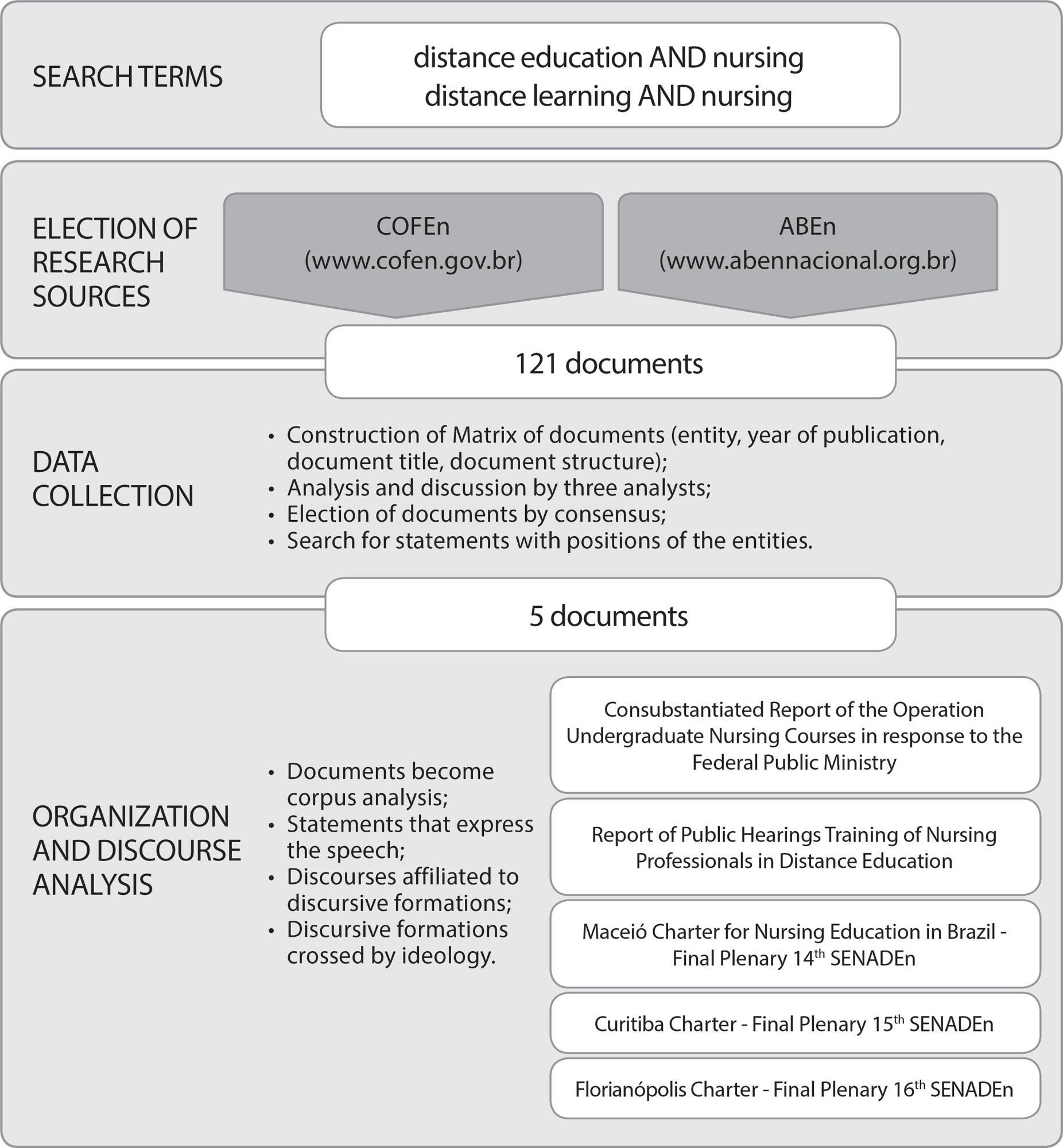
-
ARTÍCULO ORIGINAL13/07/2020
Culture of patient safety in hospital units of gynecology and obstetrics: a cross-sectional study
Revista Brasileira de Enfermagem. 2020;73(5):e20190576
Resumen
ARTÍCULO ORIGINALCulture of patient safety in hospital units of gynecology and obstetrics: a cross-sectional study
Revista Brasileira de Enfermagem. 2020;73(5):e20190576
DOI 10.1590/0034-7167-2019-0576
Visualizações0Ver maisABSTRACT
Objectives:
to assess the patient safety culture of the health team working in three maternity hospitals.
Methods:
observational, cross-sectional, comparative study. 301 professionals participated in the study. The Hospital Survey on Patient Safety Culture questionnaire validated in Brazil was used. For data analysis, it was considered a strong area in the patient safety culture when positive responses reached over 75%; and areas that need improvement when positive responses have reached less than 50%. To compare the results, standard deviation and thumb rule were used.
Results:
of the 12 dimensions of patient safety culture, none obtained a score above 75%, with nine dimensions scoring between 19% and 43% and three dimensions between 55% and 57%.
Conclusions:
no strong dimensions for safety culture were identified in the three maternity hospitals. It is believed that these results may contribute to the development of policies that promote a culture of safety in institutions.
-
ARTÍCULO DE REVISIÓN13/07/2020
The quality of life of family health professionals: a systematic review and meta-synthesis
Revista Brasileira de Enfermagem. 2020;73(5):e20190645
Resumen
ARTÍCULO DE REVISIÓNThe quality of life of family health professionals: a systematic review and meta-synthesis
Revista Brasileira de Enfermagem. 2020;73(5):e20190645
DOI 10.1590/0034-7167-2019-0645
Visualizações1Ver maisABSTRACT
Objectives:
to perform a systematic review and meta-synthesis of qualitative studies about the work-related quality of life of Family Health Strategy professionals.
Methods:
this systematic review was developed to answer the following PVO question: “Which factors (variables) are associated with the work-related quality of life (outcome) of Family Health Strategy professionals (population)?” The PubMed, Scopus, Embase, SciELO, Web of Science, LILACS, Science Direct, OpenThesis, OpenGrey, and OATD databases were selected. The meta-synthesis analyzed the main codes and secondary codes of all included studies.
Results:
the database search resulted in 1,744 reports; six were considered eligible for the meta-synthesis. Four factors were considered for the quality of work life: working conditions; work processes; interpersonal relationships; and personal aspects.
Conclusions:
although this study confirms the adequacy of aspects commonly related to the quality of work life, other factors are important in the case of FHS professionals, especially work context.
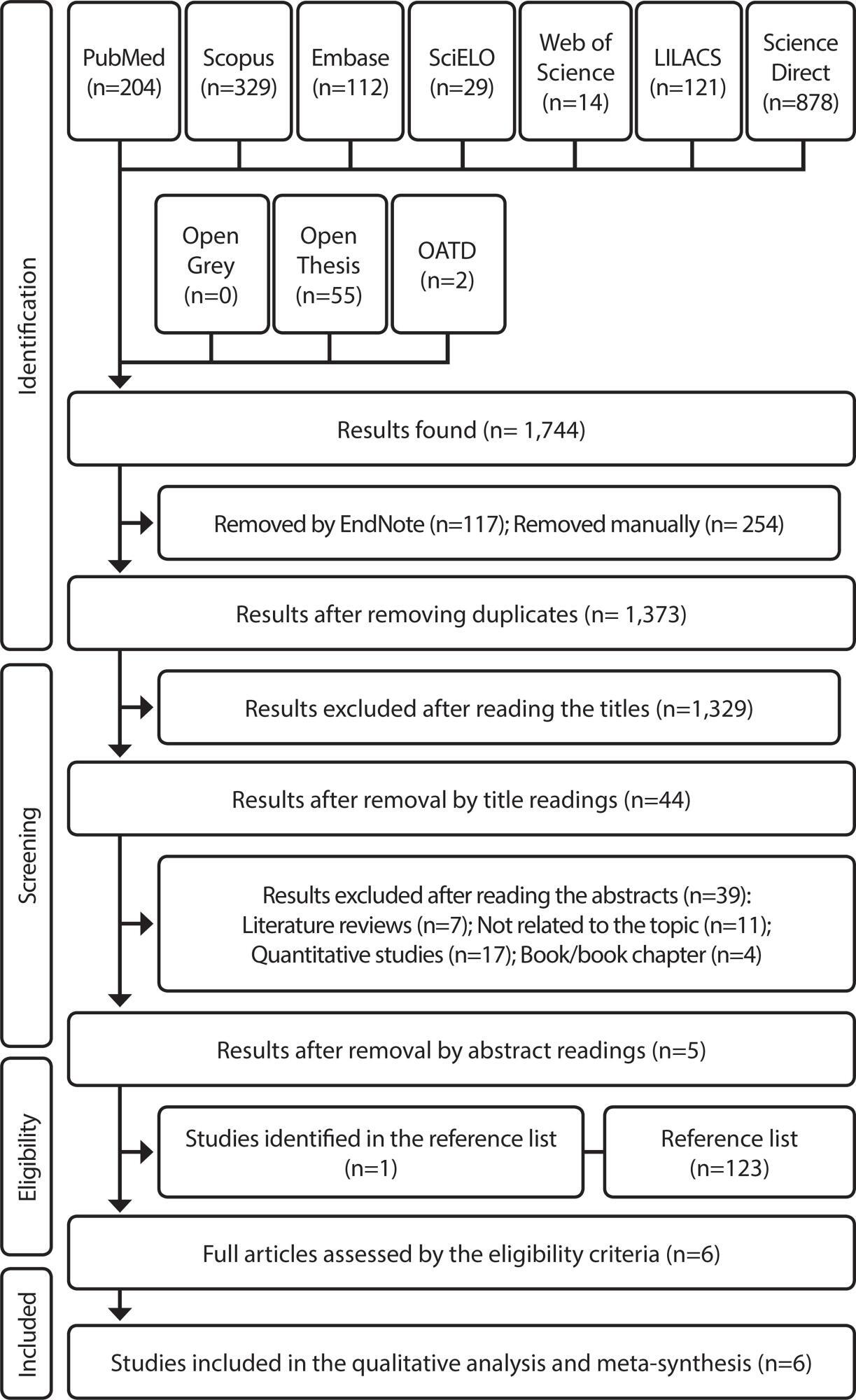
-
CARTA AL EDITOR01/07/2020
Letter to the Editor: doubts and considerations about Coronary Syndrome
Revista Brasileira de Enfermagem. 2020;73(5):e2020730502c
Resumen
CARTA AL EDITORLetter to the Editor: doubts and considerations about Coronary Syndrome
Revista Brasileira de Enfermagem. 2020;73(5):e2020730502c
DOI 10.1590/0034-7167.2020730502c
Visualizações0Dear Editor,We wrote this letter referring to the article “Impact of anxiety and depression on morbidity and mortality of patients with coronary syndrome”() to make some comments, in order to clarify doubts that we were missing from answering. We have already made it clear that our intention is not to question the work of the […]Ver mais -
ARTÍCULO ORIGINAL10/08/2020
Workers’ Health in Brazil: Accidents recorded by Social Security from 2008 to 2014
Revista Brasileira de Enfermagem. 2020;73(6):e20180892
Resumen
ARTÍCULO ORIGINALWorkers’ Health in Brazil: Accidents recorded by Social Security from 2008 to 2014
Revista Brasileira de Enfermagem. 2020;73(6):e20180892
DOI 10.1590/0034-7167-2018-0892
Visualizações0Ver maisABSTRACT
Objectives:
to analyze the incidence of occupational accidents in Brazil, recorded by Social Security according to the geographic regions, age group, gender and their prevalence according to the causes and branch of economic activity.
Methods:
ecological descriptive study with time series analysis from 2008 to 2014. Data on the beginning and end of the historical series were compared in each ecological unit studied.
Results:
the South and Southeast regions, male, between 20 and 49 years of age presented the highest falls in incidence. 70.87% of the causes occurred in group XIX of ICD-10. The economic activity with the highest prevalence of accidents was the manufacturing industry.
Conclusions:
accidents at work have decreased in Brazil, however, the incidence is still high. Advances need to be made in the recording of accidents and in the prevention and surveillance of workers’ health.
-
ARTÍCULO ORIGINAL10/08/2020
Neonatal near miss in the intensive care unit
Revista Brasileira de Enfermagem. 2020;73(6):e20180931
Resumen
ARTÍCULO ORIGINALNeonatal near miss in the intensive care unit
Revista Brasileira de Enfermagem. 2020;73(6):e20180931
DOI 10.1590/0034-7167-2018-0931
Visualizações0Ver maisABSTRACT
Objective:
To analyze near miss cases among newborns hospitalized in the Intensive Care Unit.
Methods:
An observational, cross-sectional, retrospective study using the STROBE guideline. Data were collected from 1,101 records of live births (newborns). Statistical analysis used the Epi-Info program 3.3.2 and Chi-square and Fisher’s exact tests.
Results:
A total of 162 newborns were hospitalized, of which 63 had at least one criterion of near miss. The variables that remained associated with neonatal near miss were weight <1.750 g, gestational age <33 weeks and Apgar at 5 minutes <7, pragmatic criteria to identify cases of neonatal near miss morbidity.
Conclusion:
Prematurity and low birth weight were the factors that contributed most to the near miss outcome among newborns hospitalized in intensive care, a rate two and a half times higher than the number of deaths, according to scientific evidence.

-
10/08/2020
Care for the critical patient undergoing point-of-care testing: integrative review
Revista Brasileira de Enfermagem. 2020;73(6):e20180948
Resumen
Care for the critical patient undergoing point-of-care testing: integrative review
Revista Brasileira de Enfermagem. 2020;73(6):e20180948
DOI 10.1590/0034-7167-2018-0948
Visualizações0Ver maisABSTRACT
Objective:
to identify, based on the evidence, point-of-care testing in bedbound in critically ill patients.
Method:
integrative review, carried out through search in Pubmed, Virtual Health Library, Joanna Briggs Institute, The British Institute of Radiology, Brazilian Radiology, and Google Scholar databases. We used the PICO research strategy and selected articles published from 2013 onwards, which presented information about point-of-care testing.
Results:
the different interventions found in the analysis of the 23 selected articles allowed the thematic grouping of care related to safety in communication, patient identification, care with devices, and the prevention and control of infection, which can be used in point-of-care testing.
Final considerations:
The care described in the evidence provided support for validating a safe care protocol for critically ill patients undergoing imaging studies in bed.
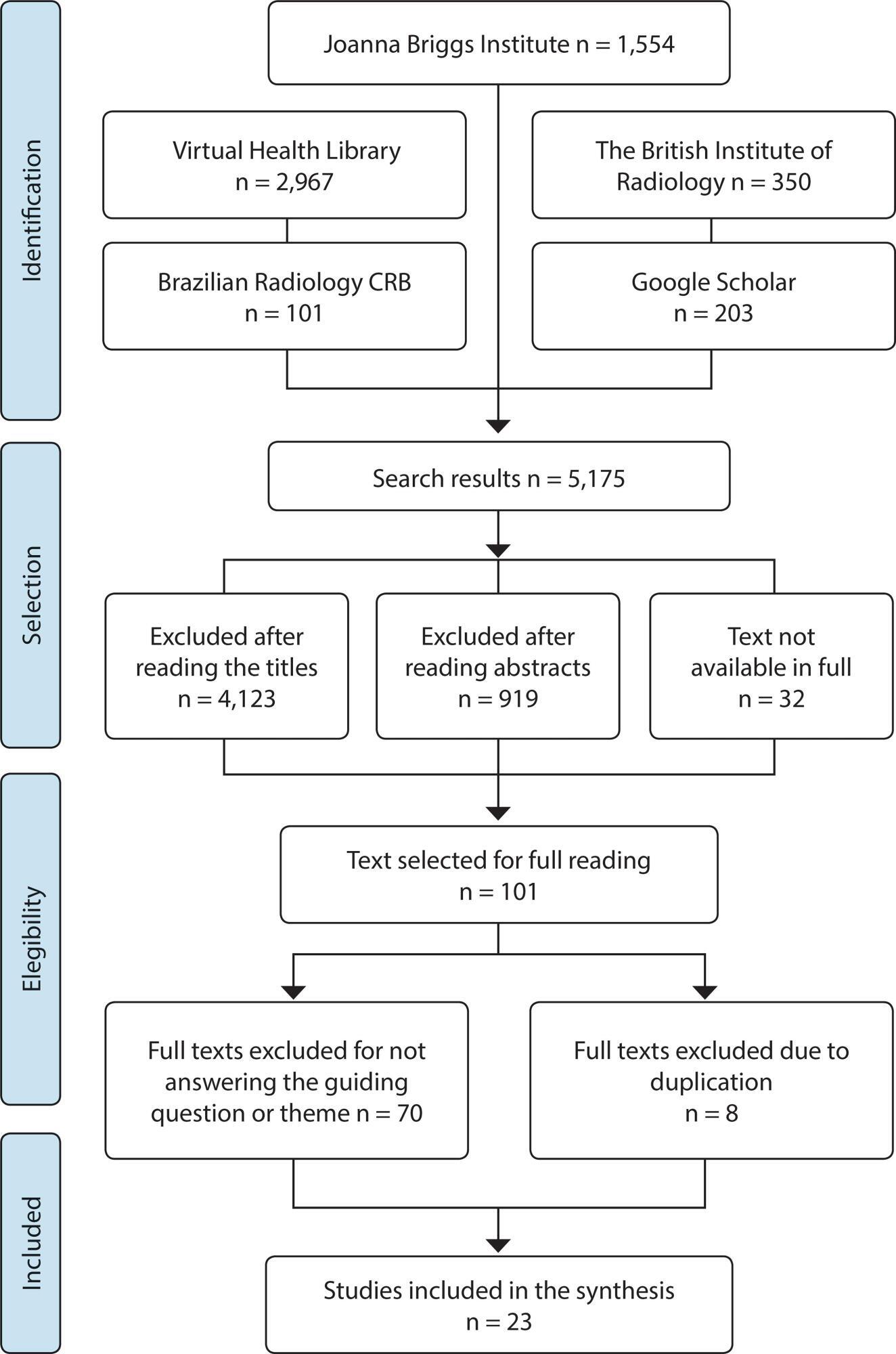
-
ARTÍCULO ORIGINAL08/06/2020
Usabilidade de um aplicativo móvel sobre o autocuidado com o pé diabético
Revista Brasileira de Enfermagem. 2020;73(4):e20180862
Resumen
ARTÍCULO ORIGINALUsabilidade de um aplicativo móvel sobre o autocuidado com o pé diabético
Revista Brasileira de Enfermagem. 2020;73(4):e20180862
DOI 10.1590/0034-7167-2018-0862
Visualizações0Ver maisRESUMO
Objetivos:
avaliar a usabilidade pelo usuário final de um protótipo de aplicativo para o autocuidado com o pé diabético.
Métodos:
estudo descritivo, de avaliação heurística da usabilidade de um aplicativo híbrido. Participaram 15 usuários de um serviço ambulatorial de atenção à pessoa com diabetes de uma capital do Nordeste brasileiro durante o mês de abril de 2018. Foi aplicado o instrumento de mensuração de usabilidade chamado Smartphone Usability questionnaiRE.
Resultados:
obteve-se como menor escore 77 e maior 112, com média de usabilidade geral de 96,1 pontos. A usabilidade foi enquadrada nos dois últimos níveis, 70 e 80. Os usuários passam a concordar fortemente (nível 70) e totalmente (nível 80) com os itens avaliados, o que representa boa usabilidade do protótipo de aplicativo.
Conclus
ões: o produto final desenvolvido tem foco nas necessidades e exigências do usuário, o que pode garantir a usabilidade, com base na tríade eficácia, eficiência e satisfação.
-
ARTÍCULO ORIGINAL18/10/2022
Percurso metodológico para alcance do grau de saturação na pesquisa qualitativa: teoria fundamentada
Revista Brasileira de Enfermagem. 2022;75(2):e20201379
Resumen
ARTÍCULO ORIGINALPercurso metodológico para alcance do grau de saturação na pesquisa qualitativa: teoria fundamentada
Revista Brasileira de Enfermagem. 2022;75(2):e20201379
DOI 10.1590/0034-7167-2020-1379
Visualizações0Ver maisRESUMO
Objetivos:
alcançar o grau de saturação em estudo que aplicou a teoria fundamentada.
Métodos:
pesquisa qualitativa, realizada em quatro Unidades Saúde da Família, entre junho de 2018 e maio de 2019. Os dados das entrevistas com 30 profissionais de saúde e observação não participante foram codificados nas etapas: aberta, axial e integração.
Resultados:
o grau de saturação foi alcançado por dois modelos conceituais – saturação teórica e temática indutiva. Foram considerados para a saturação teórica: o desenvolvimento dos códigos conceituais e a observação, na coleta e análise dos dados, quando geravam novas categorias/subcategorias ou apenas indicavam instâncias crescentes. Para a saturação temática indutiva, destacou-se a utilização de novos códigos baseados em cada entrevista.
Considerações Finais:
a esquematização visual para a quantidade de códigos, abrangência teórica dos conceitos e delimitação dos grupos amostrais orientou a identificação do grau de saturação para o desenvolvimento do corpo conceitual que sustentou a teoria substantiva.
-
ARTÍCULO ORIGINAL05/12/2019
Elderly caregivers of the elderly: frailty, loneliness and depressive symptoms
Revista Brasileira de Enfermagem. 2019;72:88-96
Resumen
ARTÍCULO ORIGINALElderly caregivers of the elderly: frailty, loneliness and depressive symptoms
Revista Brasileira de Enfermagem. 2019;72:88-96
DOI 10.1590/0034-7167-2018-0137
Visualizações0Ver maisABSTRACT
Objective:
to investigate the association between frailty, loneliness and depressive symptoms of elderly caregivers.
Method:
a cross – sectional study carried out with 341 elderly caregivers enrolled in Family Health Units of a city in the countryside of São Paulo State. The interviews were domiciliary and included questionnaire for characterization of the caregiver, Fried’s frailty phenotype, family APGAR (family functionality), Geriatric Depression Scale (depressive symptoms) and item 3 of the Herth Hope Scale (loneliness). Logistic regression was used to analyze the association between depressive symptoms and solitude (independent variables), and frailty and pre-frailty (dependent variables).
Results:
there was an association between frailty, loneliness and depressive symptoms. Elderly caregivers had increased odds of 158% presenting pre-frailty, and 360% of frailty. Elderly caregivers with depressive symptoms had an increased chance of 242% of presenting fragility.
Conclusion:
elderly and lonely caregivers with depressive symptoms are more likely to be frail and pre-frail.
-
REFLEXIÓN03/05/2021
A teoria de Florence Nightingale e suas contribuições para o pensamento crítico holístico na enfermagem
Revista Brasileira de Enfermagem. 2021;74(2):e20200139
Resumen
REFLEXIÓNA teoria de Florence Nightingale e suas contribuições para o pensamento crítico holístico na enfermagem
Revista Brasileira de Enfermagem. 2021;74(2):e20200139
DOI 10.1590/0034-7167-2020-0139
Visualizações0RESUMO
Objetivo:
refletir sobre o legado de Florence Nightingale e descrever suas contribuições para o pensamento crítico holístico na enfermagem.
Métodos:
trata-se de uma reflexão teórica, para a qual serviram de base produções científicas sobre a teoria ambientalista de Florence Nightingale, publicadas em periódicos nacionais e internacionais.
Resultados:
a filosofia e os ensinamentos de Florence Nightingale enfatizam que a enfermeira deve usar o cérebro, o coração e as mãos na criação de ambientes de cura, para cuidar do corpo do paciente, de sua mente e de seu espírito. A enfermagem, desde a época de Nightingale, vem construindo o paradigma holístico, em todas as escolas de pensamento, com vistas a uma abordagem humanística do ser humano em sua indivisível relação com o ambiente.
Considerações finais:
as contribuições de Florence ao pensamento crítico holístico na enfermagem são evidentes, constituindo o diferencial do enfermeiro na prática clínica.
Palavras-chave: Cuidados de EnfermagemEnfermagemHistória da EnfermagemPensamento CríticoTeoria de EnfermagemVer mais -
19/08/2019
Clinical simulation in nursing education in intensive therapy: an integrative review
Revista Brasileira de Enfermagem. 2019;72(4):1061-1070
Resumen
Clinical simulation in nursing education in intensive therapy: an integrative review
Revista Brasileira de Enfermagem. 2019;72(4):1061-1070
DOI 10.1590/0034-7167-2018-0217
Visualizações0Ver maisABSTRACT
Objective:
to analyze the publications on clinical simulation practices for education in Nursing in Intensive Care.
Method:
an integrative review carried out through LILACS, PubMed, Cochrane Library, CINAHL and SciELO databases, of articles published from 2008 to 2017.
Results:
29 articles were selected, of which 76% discuss the use of simulation in continuing education of nursing professionals, while the others describe their use for student education. There is a higher prevalence of studies with a level of evidence 6 (17), with 28 international publications. There was an increase in scientific production, with 16 articles published in the last three years.
Conclusion:
variables after simulation use, such as confidence, communication skills, efficiency in the identification of clinical worsening of patients, development of technical skills, teamwork and clinical decision-making, presented a significant improvement, demonstrating that this tool is effective in qualifying care for critical patients.
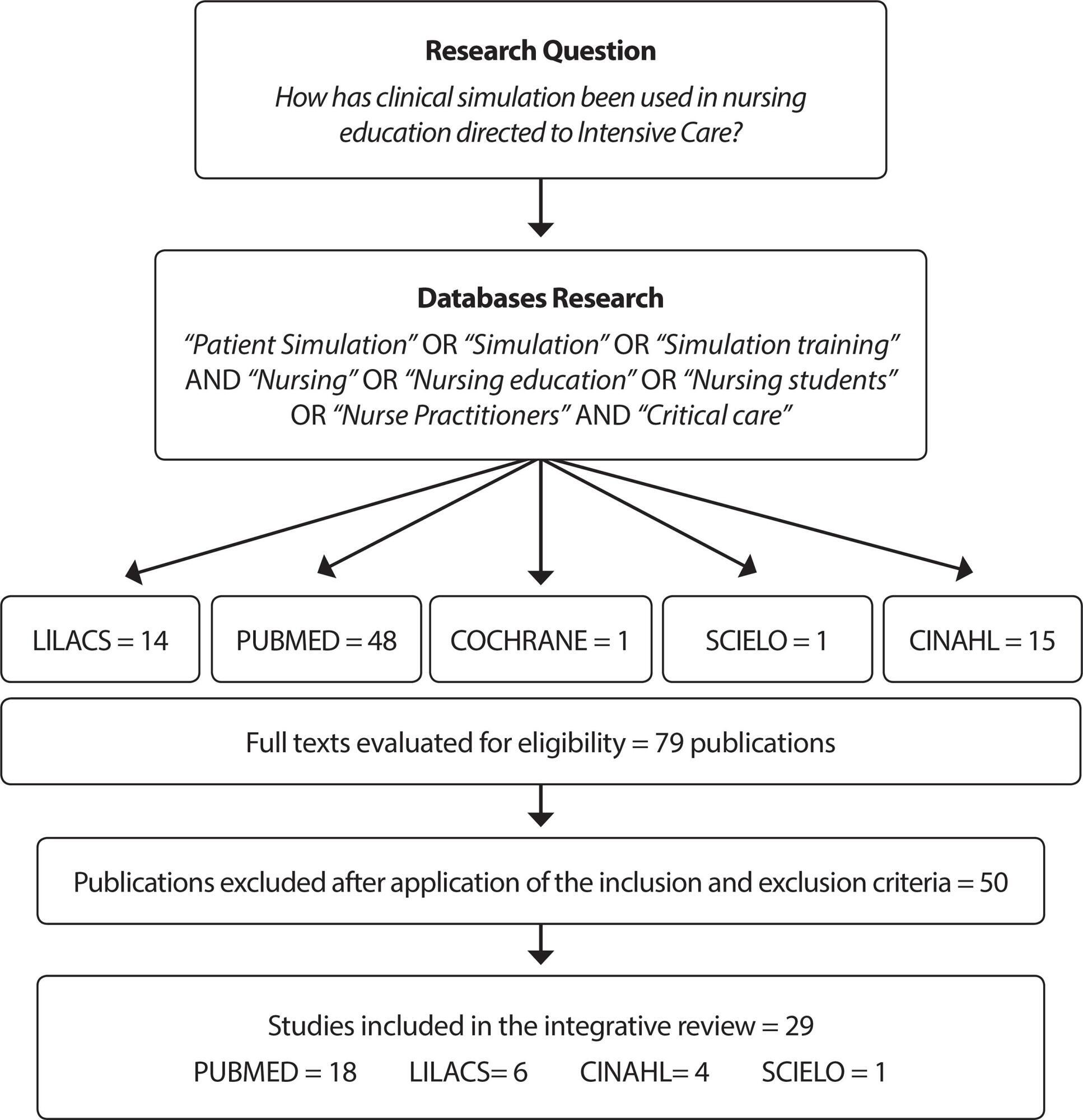
-
ARTÍCULO DE REVISIÓN26/06/2023
Barriers to Pre-Exposure Prophylaxis (PrEP) use for HIV: an integrative review
Revista Brasileira de Enfermagem. 2023;76(3):e20210963
Resumen
ARTÍCULO DE REVISIÓNBarriers to Pre-Exposure Prophylaxis (PrEP) use for HIV: an integrative review
Revista Brasileira de Enfermagem. 2023;76(3):e20210963
DOI 10.1590/0034-7167-2021-0963
Visualizações0Ver maisABSTRACT
Objectives:
to identify and synthesize scientific evidence on the barriers and difficulties for Pre-exposure Prophylaxis (PrEP) use and compliance for HIV.
Methods:
an integrative literature review, using the MEDLINE/PubMed, Cumulative Index to Nursing and Allied Health Literature (CINAHL), Academic Search Premier and Scopus (Elsevier) databases.
Results:
all (100%) the articles included identified that PrEP users experience some type of structural barrier related to health services such as long distance from the units, suboptimal logistics for taking pills and professional resistance to prescribing PrEP. Furthermore, 63.21% identified social barriers, such as stigma about sexuality and HIV, in addition to individual barriers such as alcohol use, adverse effects, and concerns about long-term toxicity.
Conclusions:
the barriers to PrEP use are multifactorial. Effective interventions are needed to support PrEP users in accessing, complying with, and retaining health services.
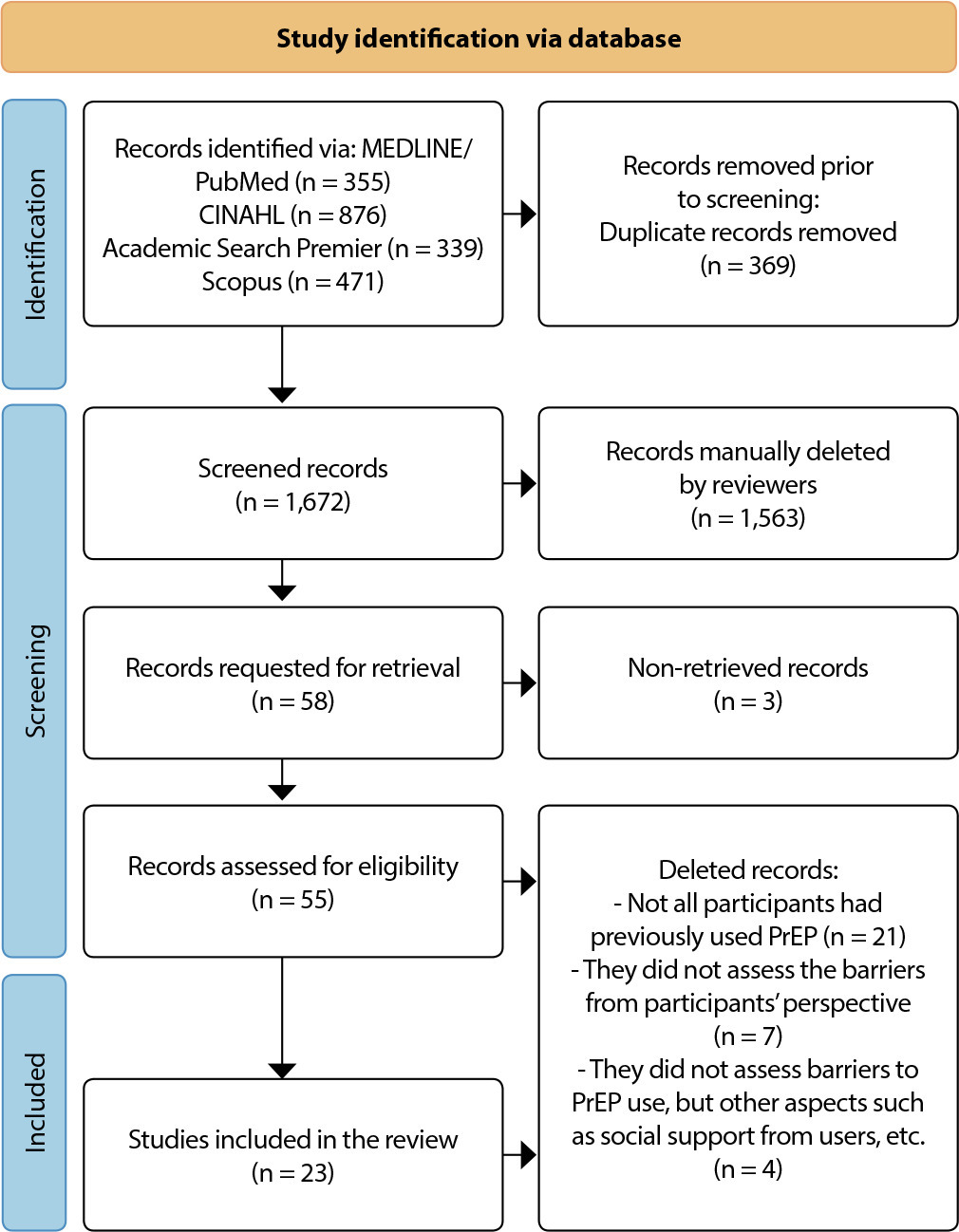
-
ARTÍCULO ORIGINAL21/10/2019
Coping religioso/espiritual e a angústia espiritual em pessoas com câncer
Revista Brasileira de Enfermagem. 2019;72(6):1534-1540
Resumen
ARTÍCULO ORIGINALCoping religioso/espiritual e a angústia espiritual em pessoas com câncer
Revista Brasileira de Enfermagem. 2019;72(6):1534-1540
DOI 10.1590/0034-7167-2018-0585
Visualizações1Ver maisRESUMO
Objetivo:
Investigar a relação entre presença de angústia espiritual e uso do coping religioso/espiritual com variáveis sociodemográficas, clínicas e de aspectos religioso/espiritual em pessoas com câncer.
Método:
Estudo transversal, realizado em uma associação de apoio à pessoa com câncer. Os dados obtidos dos instrumentos foram analisados por meio do coeficiente de correlação de Spearman e do teste Mann-Whitney.
Resultados:
Participaram do estudo 129 voluntários; 57% apresentaram moderada angústia espiritual, e 96% faziam uso de médio e alto coping religioso/espiritual positivo. A angústia espiritual apresentou correlação positiva com o coping religioso/espiritual negativo (P < 0,001) e inversa com a idade (p 0,002). O uso do coping religioso positivo foi estatisticamente significativo em pessoas que desenvolvem práticas religiosas (p 0,001).
Conclusão:
A angústia espiritual é um fenômeno presente na vida de pessoas com câncer e tem significativa relação com o uso, de maneira negativa, da religião/espiritualidade como forma de enfrentamento da doença.
-
ARTÍCULO ORIGINAL16/09/2019
Social incentives for adherence to tuberculosis treatment
Revista Brasileira de Enfermagem. 2019;72(5):1182-1188
Resumen
ARTÍCULO ORIGINALSocial incentives for adherence to tuberculosis treatment
Revista Brasileira de Enfermagem. 2019;72(5):1182-1188
DOI 10.1590/0034-7167-2017-0654
Visualizações0Ver maisABSTRACT
Objective:
To analyze the influence of social incentives for adherence to tuberculosis (TB) treatment.
Method:
Qualitative study, in which 26 primary health care professionals of São Paulo were interviewed in 2015.Their testimonies were submitted to the speech analysis technique. The theoretical reference was the social determination of the health-disease process. Ethical procedures were observed.
Results:
TB is related to precarious living conditions. Incentives such as the basic food basket and transportation stipends are relevant for patients’ adherence to treatment, as well as to the create bonds between the patient and the health team.
Final considerations:
The incentives strengthened adherence to TB treatment. However, interventions in the context of public measures must transcend the remedial dimension and be guided towards the transformation of the TB situation, which means supporting processes that modify living conditions.
Búsqueda
Buscar en:
Nuvem de Tags
Adolescente (85) Atenção Primária à Saúde (239) COVID-19 (91) Criança (91) Cuidados de Enfermagem (269) Educação em Enfermagem (151) Educação em Saúde (139) Enfermagem (930) Enfermagem Pediátrica (86) Estudantes de Enfermagem (77) Estudos de Validação (131) Família (87) Idoso (208) Promoção da Saúde (99) Qualidade de Vida (104) Saúde do Trabalhador (86) Saúde Mental (145) Saúde Pública (82) Segurança do Paciente (150) Tecnologia Educacional (100)



